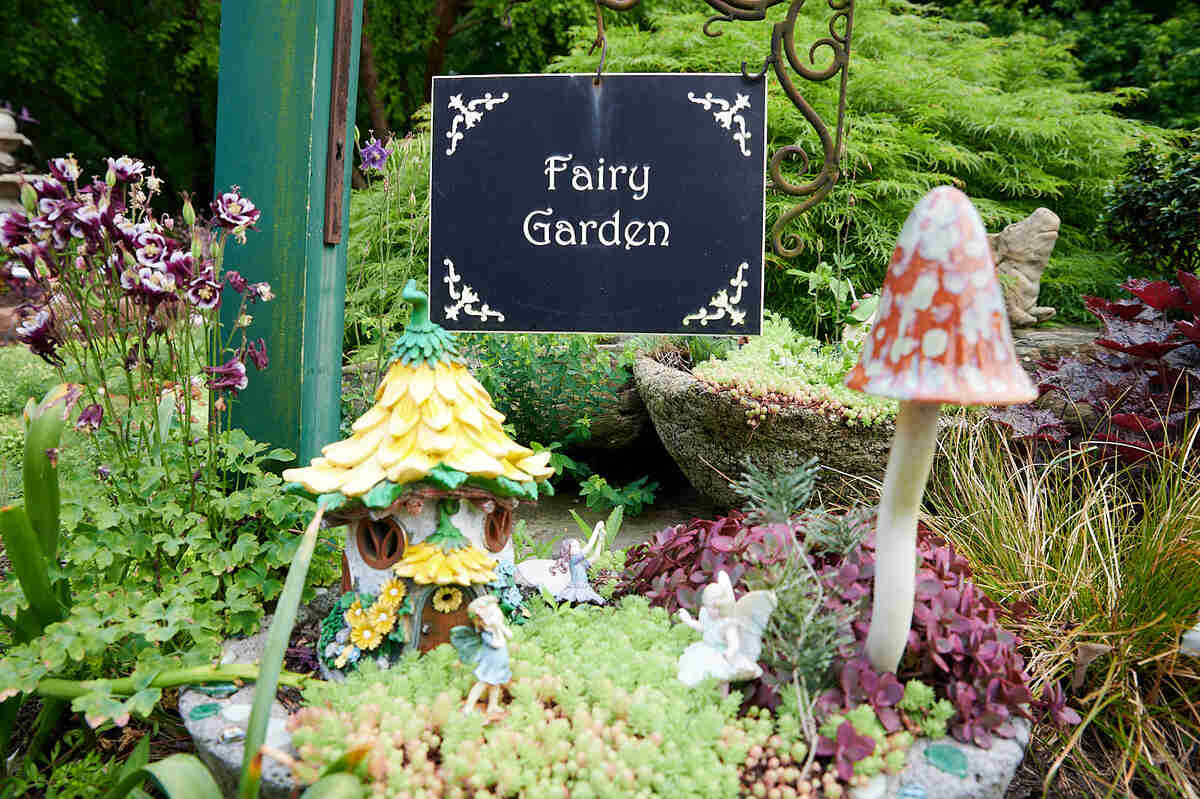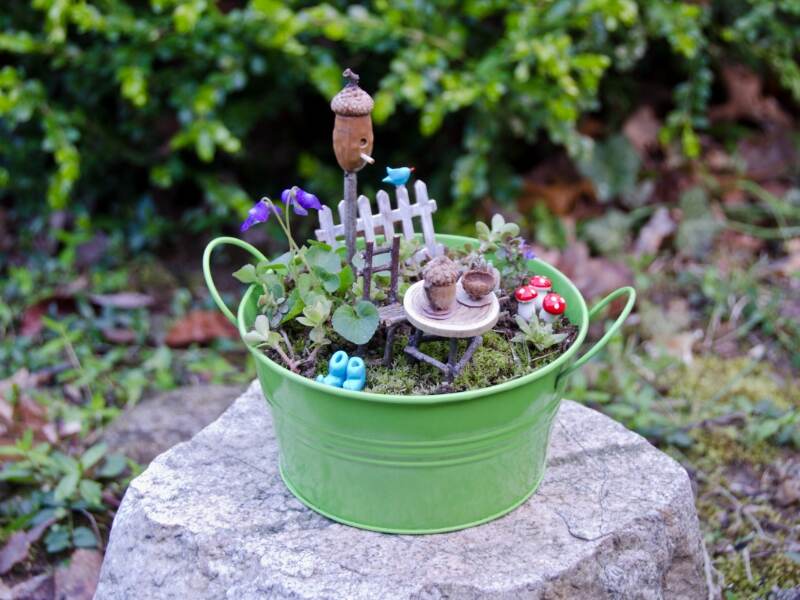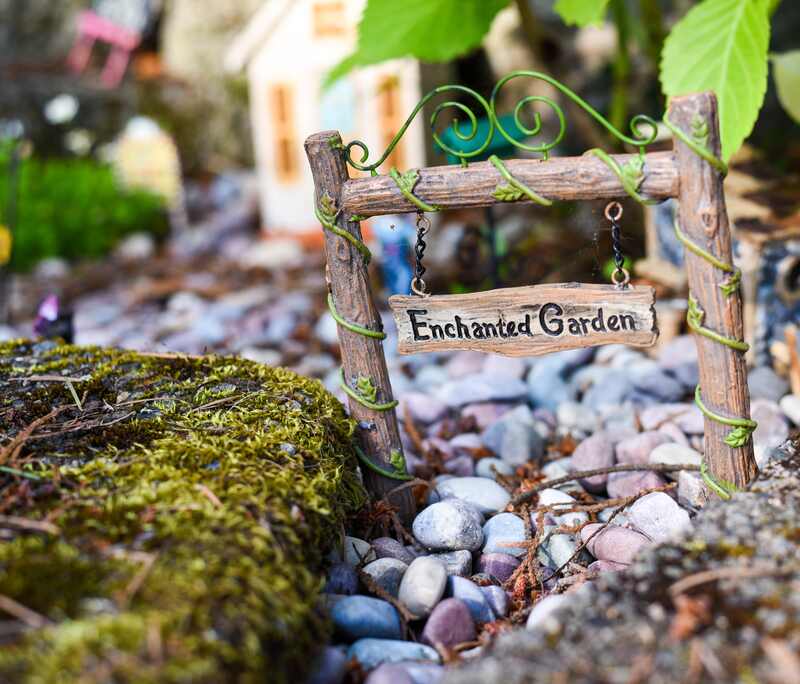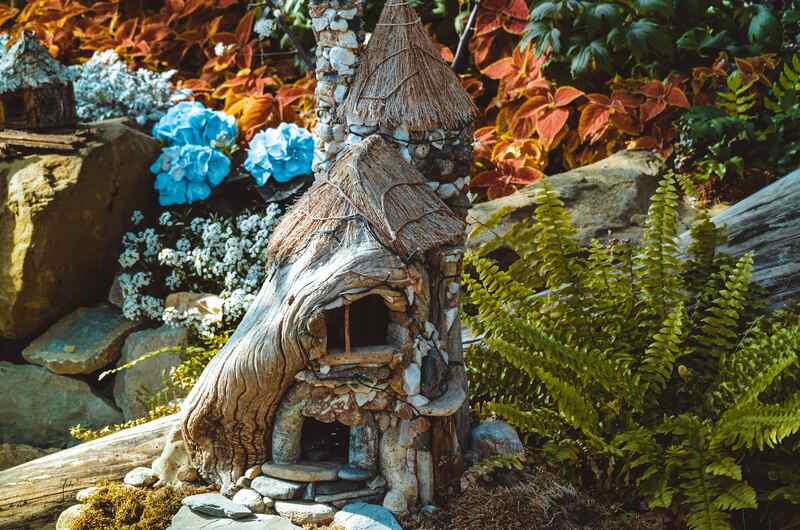
Looking for unique and enchanting fairy garden ideas? We have you covered with ideas for fairy garden locations, bases, supplies, tiny flowers and plants, and themes. Oh, and we’ll show you how to build a fairy garden, too.
What are fairy gardens? A fairy garden is a magical, usually miniature area designed to ignite the imagination with bewitching nooks, miniature magic, and flower petals, pebbles, and pieces of moss. Fantasy meets reality in designing a fairy garden.
What are the benefits of a fairy garden? A fairy garden can be a nice way to reduce stress, create a space that is easy to maintain, and even teach young children about gardening.
Whether it’s a quaint corner in your backyard, a sunlit spot on your porch, or a dedicated space on your deck, even the smallest space can become a fairy haven. And who knows, maybe a fairy or two will stop by!
Pick Your Fairy Garden Location

Find the right spot for your fairy garden is crucial. Here are some ideas for fairy garden locations:
- Indoors: Especially useful during cold months, set up a fairy garden inside. You can build a fairy garden in a terrarium. Add a touch of greenery. A fairy garden adds visual interest and intrigue in your living space.
- Raised garden beds: Elevate your magical space (literally!) by making use of a raised garden bed. A raised garden bed provides a controlled environment, perfect for curating every inch of your fairy realm.
- Repurposed containers: Turn old washtubs or unused pots into container gardens, making the most of what you already have.
- Under trees: Utilize the area at the base of a tree. The natural shade and surroundings can offer an optimal environment.
- Existing gardens: If you have a garden already, carve out a small section for the fairy garden.
Remember, the size and conditions of your selected location will influence the scale of your fairy garden and the required materials. Choose your fairy garden’s location based on space, convenience, and available resources.
Pick a Theme for Your Fairy Garden

Diving deep into the world of fairy gardens opens up various thematic possibilities. Just as authors craft worlds in novels, you have the power to shape the narrative of your little green haven. Here are a few fairy garden theme ideas that might inspire you:
- Bustling fairy village: Populate your garden with myriad fairy figurines going about their day. Add miniature market stalls, fountains, or even a tiny town square. Accessorize with small lanterns or fairy lights to evoke a lively village ambiance at night.
- Mystical forest: Envision a dense, magical woodland. Choose plants that create a canopy, and intersperse these with moss-covered stones or tiny log bridges. Ceramic woodland creatures and glow-in-the-dark elements can give it an ethereal touch.
- Medieval city: Transform your space into an age of chivalry with princesses, knights, and dragons. Integrate mini castles, moats, or even a jousting field. Metallic or stone-like accessories can enhance the medieval feel.
Pro Tip: If you’re running out of DIY fairy garden ideas, Amazon and Etsy have amazing pre-constructed fairy garden kits with little fairies, toadstools, and fairy homes.
Choose the Base for the Fairy Garden
The foundation of your fairy garden is as essential as the elements within it. Start with the right container or pot to set the tone and style for the entire garden.
Here are some popular options for fairy garden bases:
- Clay pot: Classic and breathable, allowing for good moisture retention.
- Terra cotta pot: Rustic and porous, great for preventing root rot.
- Flowerpot: Versatile and available in various styles and materials.
- Teacup: There’s nothing more adorable than a miniature teacup fairy garden for indoors.
- Garden box: Offers a larger space for those aiming for a larger setup.
- Wheelbarrow: Movable and spacious, lending a vintage touch.
- Bowl: Suitable for compact gardens and offers a modern look.
- Washtub or birdbath: Adds a repurposed, rustic charm.
While you can utilize a larger container as the main base, integrating smaller pots within can highlight specific plants or flowers, adding depth and layers to your garden.
Pro Tip: Ensure your containers or pots have drainage holes – add some if there aren’t. Don’t forget the saucer to catch the water drainage if your fairy garden is inside your home.
Gather Supplies for Your Fairy Garden

One of the most rewarding aspects of building your fairy garden is the chance to use your creativity to repurpose tiny trinkets, integrate craft items, and even infuse sentimental pieces to create something that is uniquely your own.
Here are a few ideas for supplies and needed materials as you embark on your DIY fairy garden adventure:
- Potting soil
- Small sticks or popsicle sticks
- Rocks and pebbles
- Bark
- Twine
- Acorns
- Pinecones
- Any other natural materials that resonate with you
Remember, while these materials provide a good starting point, there’s no limit to what you can add. It’s all about using what makes sense to you. Dollar stores and craft stores are also wonderful resources for fairy garden supplies.
Add Flowers and Plants

If you’re aiming to craft a miniature fairy garden, there are numerous tiny flowers and small plants perfectly suited for the task:
- Baby’s breath: Delicate and ethereal, adding a whimsical touch
- Forget-me-not: Tiny blue blooms that can symbolize lasting memories
- Thyme: Besides its aromatic appeal, its tiny leaves work great in a mini landscape
- Pansies: Their vibrant hues and patterns inject lively color
- Succulents: Drought-tolerant and diverse in shapes and shades
- Mini bonsai trees: Can be a focal point, adding an essence of age-old tranquility.
Don’t have a green thumb? No worries. Your fairy garden can still come to fruition with faux plants. They offer lasting beauty without the need for maintenance.
Populate Your Fairy Garden
The magic of a fairy garden is truly felt when you populate it with enchanting characters. Whether it’s the sheen of plastic or the delicate finish of ceramic, each figurine stands as a testament to the fairy tales we’ve all grown to adore.
Imagine a tiny ceramic fairy peeking from behind a leaf or a plastic gnome fishing by a little pond. These characters aren’t just adornments — they’re the storytellers!
But where would these characters reside? Dollhouses offer an elegant abode, perfect in scale and detail for our miniature friends. Alternatively, a creatively modified birdhouse can provide a rustic, charming home, seamlessly blending with the garden’s natural elements.
Why Create a Fairy Garden?
Fairy gardens serve as more than just decorative enclaves — they’re portals to memories, passions, and creativity! Here’s why you should create your own fairy garden:
- Memory lane: Dedicate a space to honor a loved one or friend, filling it with tokens and trinkets that bring back fond memories.
- Hobby: For those who consider gardening a favorite pastime, fairy gardens offer a unique canvas to express their gardening prowess and love for miniature gardens.
- Nostalgic nooks: Crafting a fairy garden can evoke feelings of whimsy or nostalgia, transporting you back to childhood.
- Eco-friendly alternative: Upcycle objects to give them a fresh start as central pieces in your fairytale oasis.
Creating a fairy garden is also a fun way to spend time outdoors with your kids. A fairy garden is more than just a project; it’s a chance to teach your children about caring for plants. When they add flowers or plants, your little ones will learn to water and look after them.
FAQ About Fairy Gardens
Succulents, cactus, spider plants, and the Chinese money tree plant are some of the most easy-to-care-for plants. They’re also relatively small-sized, so they can fit well in your indoor or outdoor fairy garden.
Pro Tip: If you fancy a specific larger plant, you can propagate it. Simply take a cutting, let it root, and then plant it in a small pot. This way, you get a miniature version, combining aesthetics with ease of care.
Your succulent garden should typically be watered once a week. Ensure the soil completely dries out between waterings. This prevents overwatering, which succulents are particularly sensitive to.
A sensory garden is a specially designed outdoor area that harnesses various plants and elements to engage and heighten all five senses — sight, sound, taste, touch, and smell. It offers an immersive experience, allowing individuals to connect deeply with nature.
Given its multi-sensory appeal, a sensory garden can be a fantastic addition to a fairy garden, blending the whimsy of fairy tales with the tangible stimulation of the senses.
When to Call a Gardening Professional
If your DIY fairy garden has inspired you to take on a full-fledged garden and you’re not sure what steps to take, connect with a landscape and gardening professional near you to make your fairy garden fantasy a reality.
Main Image Credit: Bob Klannukarn / Flickr / CC BY-SA 2.0